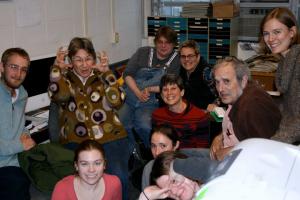Serendip is an independent site partnering with faculty at multiple colleges and universities around the world. Happy exploring!
What's My Brain Like?

When Anne and I met a few days ago she asked me to describe my brain. Her question surprised me. I’ve never really thought about my brain as something tangible; I haven’t thought about its tactility or what it might look like. So just now I closed my eyes and took a few minutes to envision my brain, to think about metaphors. I see it as being covered in Christmas lights—lights that flash on and off, some whose fuses break, some that shine brightly, others dimly. It’s colorful. Sometimes, when I’m really anxious, the red bulbs glow intensely and when I’m calm the purples and yellows emerge. Like a lollipop, my brain is also sticky. It remembers too many things, things I don’t want to think about or dwell on, but things that end up nagging at me, that tear away at my insides. My brain also moves quickly. It holds an Olympic world record in the fifty-meter dash. And to allude to Aesop’s famous fable, it’s not the tortoise, but the hare and, as we know, despite the hare’s briskness and agility, it never seems to get anywhere in end. Like the hare, the faulty part of my brain bloats and brags. It claims to know everything, to be an expert on living, and demands that I listen. But in the end, it's always wrong. It sends me down long, complicated paths and dead ends to ensure that myself and others are safe, but it only tries my patience and drains my energy.
I grew up thinking that my brain equated me. The hardest thing I’ve had to learn throughout treatment for my OCD is that because my brain is faulty, not all of my thoughts are my own. My fear messages are overactive. In a way, they’re merely a survival mechanism that acts to excess; but instead of helping me, they become only detrimental. So in a lot of ways I’ve learned to work against my brain or at least use the logical part of my brain to dismiss the illogical part. I’ve had to become good at sorting. I’m the mailman in the mailroom who decides which messages are important or have priority and which don’t. I have to opt for the logic of the tortoise rather than the hare.



Comments
more on varieties of brains....
So I thought you'd be amused to know that I used your post to seed an exercise in my Gender and Technology class; I asked each student to tell one another what her mind was like. And my co-teacher, who is a physicist, and interested in the varieties of ways in which data can be organized into information, created a pie chart of the patterns our minds made--and then invited students to create alternative patterns. Here's one of those imaginings...
on slippery brains, and briar-like ones
You know, of course, An Active Mind, that a lot of the questions you are exploring here are also on the table @ the meetings of the Slippery Brain Sodality. What you might not know--and this makes me laugh out loud--is that there has been some recent conversation on that site about the "briar-ly brains" (like my own) which have entered the mix, and how they are like-and-different from the "slippery" ones (for example, in the sorts of novels they are drawn to, and linger over...)
